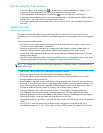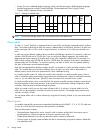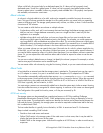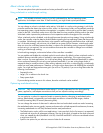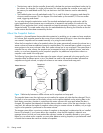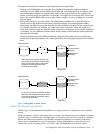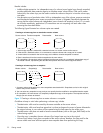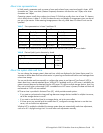
HP StorageWorks 2000 G2 Modular Smart Array Reference Guide 23
About the VDS and VSS hardware providers
Virtual Disk Service (VDS) enables host-based applications to manage vdisks and volumes. Volume
Shadow Copy Service (VSS) enables host-based applications to manage snapshots. For more information,
see the VDS and VSS hardware provider documentation for your product.
About RAID levels
The RAID controllers enable you to set up and manage vdisks, whose storage may be spread across
multiple disks. This is accomplished through firmware resident in the RAID controller. RAID refers to vdisks
in which part of the storage capacity may be used to store redundant data. The redundant data enables
the system to reconstruct data if a disk in the vdisk fails.
Hosts see each partition of a vdisk, known as a volume, as a single disk. A volume is actually a portion of
the storage space on disks behind a RAID controller. The RAID controller firmware makes each volume
appear as one very large disk. Depending on the RAID level used for a vdisk, the disk presented to hosts
has advantages in fault-tolerance, cost, performance, or a combination of these.
NOTE: Choosing the right RAID level for your application improves performance.
The following tables:
• Provide examples of appropriate RAID levels for different applications
• Compare the features of different RAID levels
• Describe the expansion capability for different RAID levels
Table 4 Example applications and RAID levels
Application RAID level
Testing multiple operating systems or software development (where redundancy is not an issue) NRAID
Fast temporary storage or scratch disks for graphics, page layout, and image rendering 0
Workgroup servers 1 or 10
Video editing and production 3
Network operating system, databases, high availability applications, workgroup servers 5
Very large databases, web server, video on demand 50
Mission-critical environments that demand high availability and use large sequential workloads 6
Table 5 RAID level comparison
RAID
level
Min.
disks
Description Strengths Weaknesses
NRAID 1 Non-RAID, nonstriped
mapping to a single disk
Ability to use a single disk to store
additional data
Not protected, lower performance
(not striped)
0 2 Data striping without
redundancy
Highest performance No data protection: if one disk
fails all data is lost
1 2 Disk mirroring Very high performance and data
protection; minimal penalty on
write performance
High redundancy cost overhead:
because all data is duplicated,
twice the storage capacity is
required
3 3 Block-level data striping
with dedicated parity
disk
Excellent performance for large,
sequential data requests (fast
read)
Not well-suited for
transaction-oriented network
applications: single parity disk
does not support multiple,
concurrent write requests



